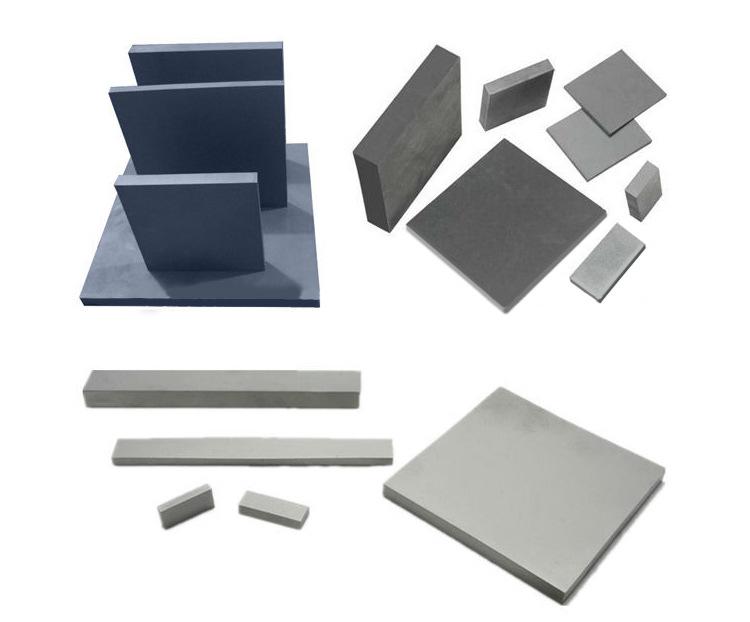Cemented carbide is a kind of alloy made by powder metallurgy with one or several refractory carbides (tungsten carbide, titanium carbide, etc.) as main components and metal powders (cobalt, nickel, etc.) as adhesive. It is mainly used to manufacture high-speed cutting tools and cutting tools for hard and tough materials, as well as cold working dies, measuring tools and high wear-resistant parts free from impact and vibration.
Characteristics of cemented carbide
(1) High hardness, wear resistance and red hardness
The hardness of cemented carbide can reach 86 ~ 93HRA at room temperature, which is equivalent to 69 ~ 81hrc. It can maintain high hardness and excellent wear resistance at 900 ~ 1000 ℃. Compared with high speed tool steel, the cutting speed is 4 ~ 7 times higher, the service life is 5 ~ 80 times longer, and the hardness of hard material can be up to 50HRC.
(2) High strength and elastic modulus
The compressive strength of cemented carbide is as high as 6000mpa, and the elastic modulus is (4 ~ 7) × 105Mpa, which is higher than that of high speed steel. But its bending strength is low, generally 1000 ~ 3000mpa.
(3) Good corrosion resistance and oxidation resistance
Generally, it can resist the corrosion of atmosphere, acid and alkali, and is not easy to be oxidized.
(4) The coefficient of linear expansion is small
When working, the shape and size are stable.
(5) Formed products are no longer processed and reground
Due to the high hardness and brittleness of cemented carbide, no cutting or regrinding is needed after powder metallurgy forming and sintering. Only EDM, WEDM, electrolytic grinding or special grinding wheel can be used for regrinding. Usually, products of certain specifications made of cemented carbide are brazed, bonded or mechanically clamped on the cutter body or die.

Common cemented carbide
The commonly used cemented carbides can be divided into three categories according to their composition and properties: tungsten cobalt, tungsten titanium cobalt and tungsten titanium tantalum (niobium). Tungsten cobalt and tungsten titanium cobalt cemented carbides are widely used in production.
(1) Tungsten cobalt cemented carbide
The main components are tungsten carbide (WC) and cobalt. The brand name is YG (“hard” and “cobalt” Chinese Pinyin prefix), followed by the percentage value of cobalt content. For example, YG6 represents tungsten cobalt cemented carbide with 6% cobalt content and 94% tungsten carbide content.
(2) Tungsten titanium cobalt cemented carbide
The main components are tungsten carbide (WC), titanium carbide (TIC) and cobalt. The brand name is YT (“hard” and “titanium” prefix), followed by the percentage value of titanium carbide content. For example, YT15 represents tungsten titanium cobalt cemented carbide with 15% titanium carbide content.
(3) Tungsten titanium tantalum (niobium) cemented carbide
This kind of cemented carbide, also known as universal cemented carbide or universal cemented carbide, is mainly composed of tungsten carbide (WC), titanium carbide (TIC), tantalum carbide (TAC) or niobium carbide (NBC) and cobalt. The trademark is indicated by the code YW (hard, Wan Chinese Pinyin prefix) followed by an ordinal number.

Application of cemented carbide
(1) Tool material
Cemented carbide is the most widely used tool material, which can be used for turning tool, milling tool, planer, drill bit, etc. Tungsten cobalt cemented carbides are suitable for short chip processing of ferrous metals and non-ferrous metals and processing of non-metallic materials, such as cast iron, cast brass, bakelite, etc.; tungsten titanium cobalt cemented carbides are suitable for long chip processing of ferrous metals such as steel. In the same kind of alloy, the one with more cobalt content is suitable for rough machining, and the one with less cobalt content is suitable for finish machining. The working life of general cemented carbide for stainless steel and other difficult to machine materials is much longer than that of other cemented carbide.
(2) Mould material
Cemented carbide is mainly used as cold drawing die, cold punching die, cold extrusion die, cold pier die and other cold working dies.
Under the working condition of bearing impact or strong impact, the common feature of cemented carbide cold heading die is that it requires cemented carbide to have better impact toughness, fracture toughness, fatigue strength, bending strength and good wear resistance. Medium and high cobalt and medium and coarse grain alloy grades are usually selected, such as yg15c.
Generally speaking, the relationship between wear resistance and toughness of cemented carbide is contradictory: the improvement of wear resistance will lead to the decrease of toughness, and the improvement of toughness will inevitably lead to the decrease of wear resistance. Therefore, in the selection of alloy grades, it is necessary to meet the specific requirements according to the processing objects and processing conditions.
If the selected brand is easy to cause early cracking and damage in use, the brand with higher toughness should be selected; if the selected brand is easy to cause early wear and damage in use, the brand with higher hardness and better wear resistance should be selected. The hardness, wear resistance and toughness of the following brands: yg15c, yg18c, YG20C, yl60, yg22c and yg25c decrease from left to right, and vice versa.
(3) Measuring tools and wear parts
Cemented carbide is used for wear-resistant parts of measuring tools, precision bearing of grinder, guide plate and guide rod of centerless grinder, lathe center, etc.









